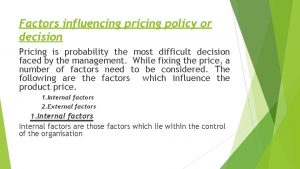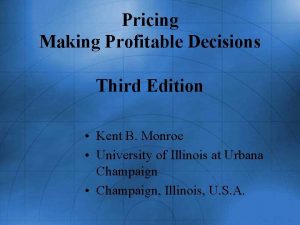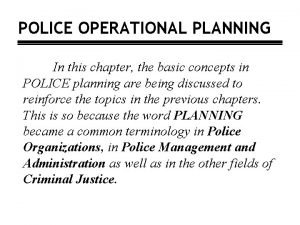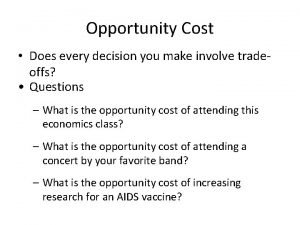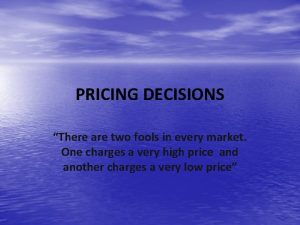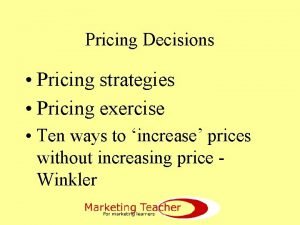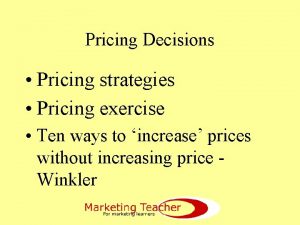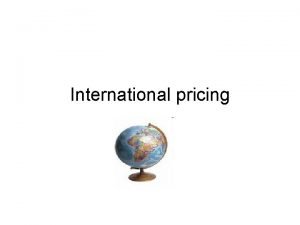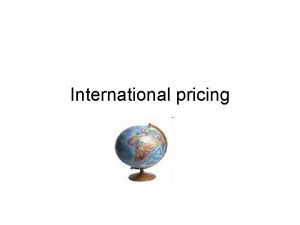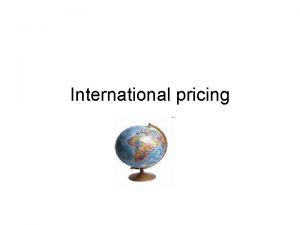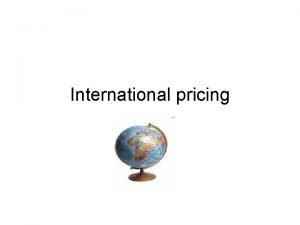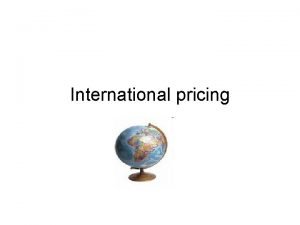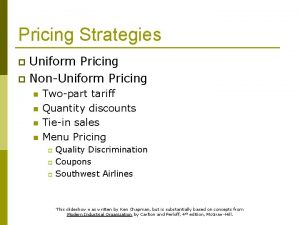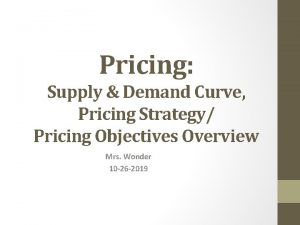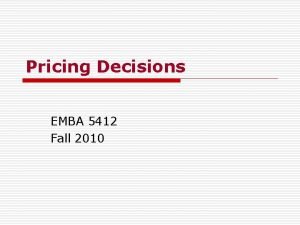PRICING DECISIONS There are two fools in every


























- Slides: 26

PRICING DECISIONS “There are two fools in every market. One charges a very high price and another charges a very low price”

• Definition – The amount of money charged for a product or service, or the sum of the values that consumers exchange for the benefits of having or using the product or service. (Kotler and Armstrong) • Different terms are used to refer to price depending on what's being paid for – rent, fare, fee, interest, tuition, premium, salary, bride price.

Factors to consider when setting price • INTERNAL and EXTERNAL factors • Internal factors • 1. Marketing objectives – The overall strategy for the product will affect price. The selected target market and positioning matters. Eg a product intended for an exclusive up market will be priced highly. Other objectives include:

- Survival Current profit maximization Market share objectives Product quality leadership Keep competitors from entering the market 2. Marketing mix strategy – Price decisions must be coordinated with other elements of the marketing mix. Eg The decision to position a product on high performance quality means that its price should be high.

• 3. Cost - This sets the floor for the price that a company can charge. Price charged should cover all costs and allow a fair return on investment. • 4. Organizational considerations – Who within the organization sets prices? • In small companies, prices are set by top management.

• In large companies, price is set by divisional or product line managers • In industrial markets, sales people negotiate with customers within certain price ranges. • Some companies have a pricing department that reports to the marketing dept or top management.

5. Stage of the product in the PLC. External factors 1. The market and demand – These set the upper limit of prices. Before setting prices, marketers must understand the relationship between price and demand for its product.

• The type of market affects pricing. • - PERFECT COMPETITION : Many buyers and sellers. There is a going price for the product. • - MONOPOLISTIC COMPETION : Market has many buyers and sellers who trade over a range of prices. Products are differentiated, so customers are willing to pay different prices for similar products.

• - OLIGOPLISTIC COMPETITION : Market has few sellers who are sensitive to each other’s pricing. • - PURE MONOPLY : There is only one seller in the market. The non regulated monopoly is free to set price that the market will bear. A government monopoly may set price below cost to make the product affordable.

• Or it may price to cover cost or to earn good revenue. • Consumer perception of price and value – This also affects price. Consumers expect the price to conform to the value they attach to the product. • Price elasticity of demand – The sensitivity of demand to change in price.

• Demand may be elastic or inelastic. • 2. Competitors – Their costs, prices, and offers. How are they likely to react to the company’s pricing moves? • Use these as a starting point for pricing • 3. Economic conditions – inflation, interest rates, boom or recession. These affect the cost of producing a product and consumer perceptions of price and value.

• 4. Government regulations • 5. Social concerns

Pricing approaches • Cost based pricing: • a) Cost plus pricing – add a standard mark up to the cost of the product. • B) break even pricing – Set price to break even on the costs of making and marketing a product • Competition based pricing – Pricing that focuses on what competitors are doing.

• a) Going rate pricing - Base price largely on competitors prices with minimum attention to own costs or demand. Charge a price that is same, more, or less than major competitors. In Oligopoly markets, there is a price leader that others follow. • b) Sealed bid pricing – Price is based on what the firm thinks competitors are quoting.

• Value based pricing – Setting price based on buyers’ perceptions of value rather than on the seller’s cost. The company sets its target price based on customer perceptions of the product value. These drive decisions about product design and what costs can be incurred. Thus pricing begins with analyzing consumer needs and value perceptions, and price is set to march the perceived value.

Pricing strategies A look at pricing strategies available to address different situations. New product pricing strategies a) Pricing for a product that imitates existing products – The product has to be positioned against competing products in terms of quality and price. There are 4 positioning strategies:

• - Premium pricing strategy : High quality product with a high price. • - Good value strategy : High quality product sold at a lower price • - Overcharging strategy : Overcharge the product in relation to its quality • - Economy strategy : Producing a low quality product and charging a low price.

• b) Pricing for an innovative product – There are two options. • - Market skimming pricing • - Market penetration pricing

• Product mix pricing strategies – When a company has a wide range of products, the pricing of individual products is done taking into account other products in the mix. • a) Product line pricing – Setting the price steps between various products in a line, based on cost differences between products, customer evaluations of different features, and competitors prices.

• b) Optional product pricing – Pricing of optional or accessory products that are being sold along with a main product. A decision has to be made on which items to include in the base price and which ones to offer as options. • C) Captive product pricing – Setting a price for products that must be used along with a main product. A low price may be set for the main product and a high markup set for the supplies.

• For services, there is two part pricing. Price is broken into a fixed fee plus a variable usage rate. The fixed fee should be low enough to induce usage of the service and a profit can be made on the variable fee. • c) By product pricing – Setting price for by products in order to make the main product’s price more competitive

• Accept a price for the by product that covers more than the cost of storage and delivery. This allows you to reduce the main product’s price and make it more competitive. • e) product bundle pricing – Combining several products and offering the bundle at a reduced price. The bundling can promote the sales of products that consumers might not otherwise buy.

• Price adjustment strategies – Companies may adjust the basic price to take into account customer differences and changing situations • a) Discount and allowance pricing : Adjust price to reward customers for certain responses. Includes, cash discount, quantity discount, trade discount, seasonal discount, trade in allowance, promotional allowance.

• b) Segmented pricing – Also called price discrimination. Selling products or services at two or more prices, even though the difference in prices is not based on differences in costs • C) Psychological pricing – Setting prices to take advantage of non logical reactions of consumers to certain types of prices.

• Examples are odd pricing and prestige pricing. • d) Promotional pricing – Using price as promotion tool. Temporarily reduce price to increase sales. Examples include: • * Loss leader pricing • * Special event pricing • * Special season pricing

• e) Geographical pricing – Deciding how to price products for customers located in different locations
 Meaning of poster making
Meaning of poster making Mikael ferm
Mikael ferm Screening decisions and preference decisions
Screening decisions and preference decisions Factors influencing international pricing
Factors influencing international pricing Pricing and output decisions in perfect competition
Pricing and output decisions in perfect competition Pricing decisions and cost management
Pricing decisions and cost management Pricing: making profitable decisions
Pricing: making profitable decisions Neil simon fools
Neil simon fools Kenn nesbitt poems
Kenn nesbitt poems Portugal april fools day
Portugal april fools day Competent jerk
Competent jerk Fool's guard
Fool's guard Cern april fools proposal for space
Cern april fools proposal for space Fools gold
Fools gold Knaves and fools definition
Knaves and fools definition Every nation and every country
Every nation and every country Microsoft's mission statement
Microsoft's mission statement Every knee shall bow every tongue confess
Every knee shall bow every tongue confess Every rotarian every year
Every rotarian every year Every nation and every country
Every nation and every country Every picture has a story and every story has a moment
Every picture has a story and every story has a moment Every child every day
Every child every day Parts of police operational plan
Parts of police operational plan For every action there is an equal and opposite reaction
For every action there is an equal and opposite reaction Law of interaction
Law of interaction Opportunity costs and trade offs
Opportunity costs and trade offs There is candle in every soul
There is candle in every soul



